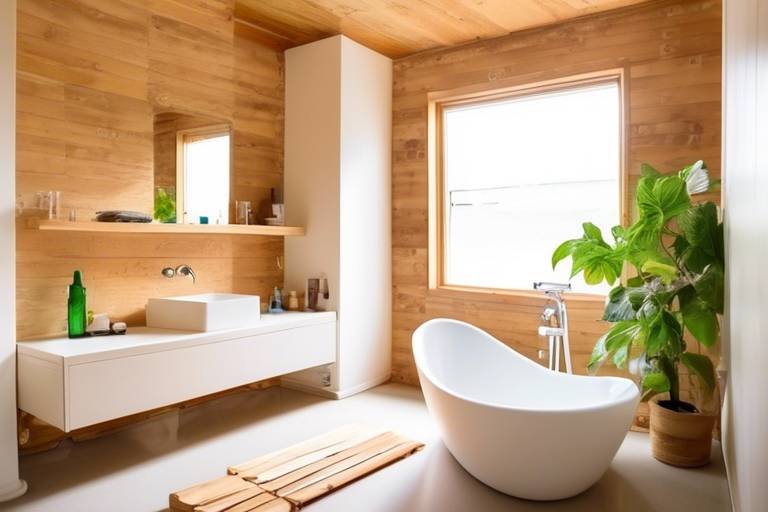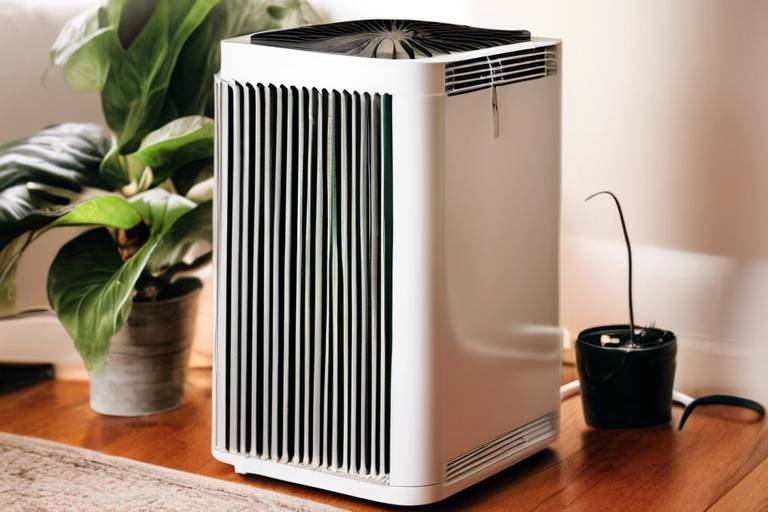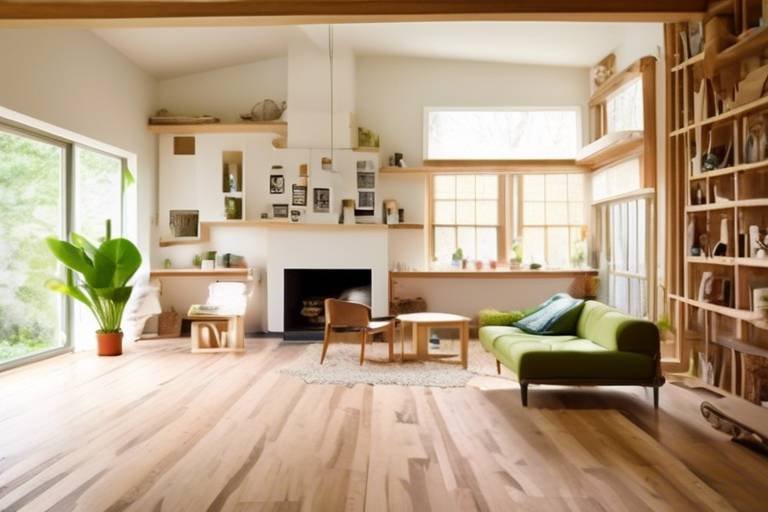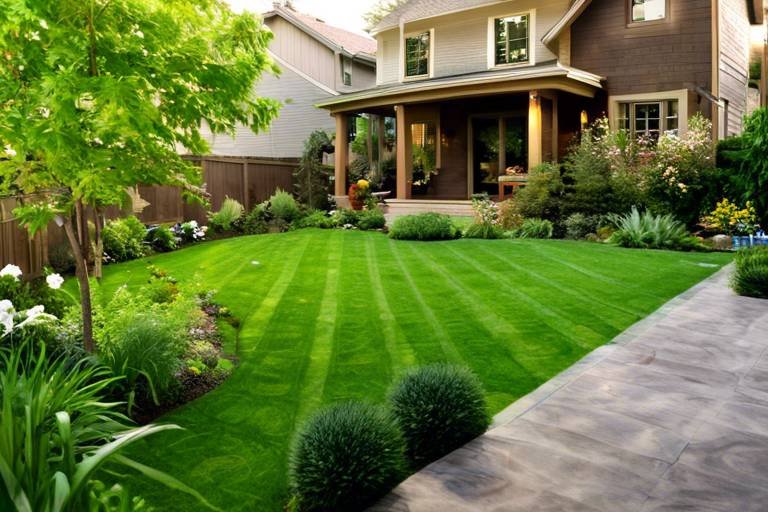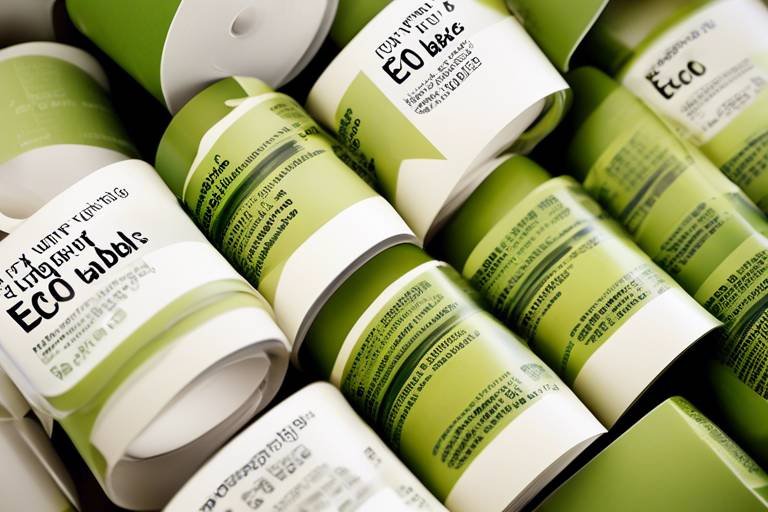How to Create a DIY Natural Pool
Are you tired of the harsh chemicals and high maintenance of traditional swimming pools? Have you ever dreamed of having your own serene oasis right in your backyard, where you can swim in crystal-clear water surrounded by lush greenery? Well, it's time to turn that dream into a reality by creating your very own DIY natural pool!
Imagine stepping into a pool that not only refreshes your body but also rejuvenates your soul, all while being in harmony with nature. A natural pool offers a unique swimming experience that goes beyond just recreation—it's a holistic retreat that brings you closer to the environment and promotes a sense of well-being.
Creating a DIY natural pool is not only a rewarding project but also a sustainable choice that benefits both your health and the planet. By using eco-friendly methods and materials, you can enjoy a chemical-free swimming experience that is gentle on your skin and the environment.
From designing the layout to selecting the right plants and building a natural filtration system, every step of creating a natural pool is an opportunity to connect with nature and unleash your creativity. By incorporating a balanced ecosystem and a regeneration zone, you can ensure that your pool remains clean, clear, and thriving with life.
So, are you ready to embark on this exciting journey of creating your own DIY natural pool? Get ready to dive into the world of sustainable swimming and discover the joy of having your own chemical-free oasis right at home!

Benefits of Natural Pools
When it comes to swimming pools, the allure of a natural pool goes beyond just a refreshing dip on a hot day. The benefits of natural pools are numerous and impactful, offering a unique swimming experience that is both eco-friendly and sustainable. Unlike traditional chlorine pools, natural pools utilize plants and natural filtration systems to maintain water quality, resulting in a chemical-free oasis that is not only better for the environment but also for your health.
One of the key advantages of natural pools is the lower maintenance costs associated with them. By harnessing the power of nature to filter and clean the water, natural pools require less maintenance and fewer chemical treatments, saving you time and money in the long run. Additionally, the reduced environmental impact of natural pools cannot be overlooked. By avoiding the use of harsh chemicals, natural pools help protect the ecosystem and promote biodiversity in your backyard.
Furthermore, swimming in a natural pool offers a healthier experience for you and your family. The absence of chlorine and other chemicals means that you can enjoy a swim without exposing yourself to potentially harmful substances. Natural pools provide a more balanced and harmonious environment, benefiting both swimmers and the surrounding ecosystem.

Designing Your Natural Pool
Designing your own natural pool is an exciting journey that allows you to blend the beauty of nature with the functionality of a swimming oasis right in your backyard. When embarking on this creative endeavor, there are several key elements to consider to ensure that your DIY natural pool not only looks stunning but also functions efficiently.
First and foremost, think about the layout of your natural pool. Consider the available space in your backyard and how you want the pool to integrate with the surrounding landscape. The shape of the pool is also crucial - whether you prefer a more organic, free-form design or a more structured and geometric shape, it should complement the overall aesthetics of your outdoor space.
Size matters when it comes to designing your natural pool. Determine how large you want the pool to be based on your intended use, the number of swimmers, and the available space. Remember that a larger pool may require more maintenance and resources, so finding the right balance is key.
Another important aspect to consider is the depth of your natural pool. Different areas of the pool can have varying depths to accommodate different activities, such as swimming, wading, or aquatic plant growth. Creating different zones within the pool can enhance both its visual appeal and functionality.
When designing your natural pool, don't forget about safety features such as steps, ledges, or shallow areas for children or non-swimmers. Incorporating these elements not only enhances the usability of the pool but also ensures a safe and enjoyable swimming experience for everyone.
Additionally, think about how you want to access and circulate the water in your natural pool. Consider the placement of skimmers, pumps, and filtration systems to maintain water quality and clarity. Proper circulation and filtration are essential for keeping your pool clean and healthy for both swimmers and aquatic life.

Choosing the Right Plants
When it comes to creating your own natural pool, choosing the right plants is a crucial step in ensuring the health and beauty of your aquatic oasis. Native aquatic plants play a vital role in maintaining water quality, providing habitat for beneficial organisms, and supporting the overall ecosystem of your natural pool. By carefully selecting the appropriate plants, you can enhance the aesthetics of your pool while promoting a balanced and thriving environment.
One key consideration when selecting plants for your natural pool is choosing species that are native to your region. Native plants are well-adapted to the local climate and environmental conditions, making them more likely to thrive and require less maintenance. Additionally, native plants help support local wildlife populations and contribute to the biodiversity of your backyard ecosystem.
Another important factor to keep in mind is the growth habits of the plants you choose. Opt for a variety of plant species that offer a range of heights, textures, and foliage to create visual interest and diversity in your natural pool. Consider plants that can float on the water's surface, submerge below the surface, or grow along the edges to create different habitats for aquatic creatures.
When designing your plant selection, think about the specific functions each plant will serve in your natural pool. Some plants are known for their ability to oxygenate the water, while others help filter out excess nutrients and prevent algae growth. By incorporating a mix of oxygenating, filtering, and aesthetic plants, you can create a balanced ecosystem that promotes water clarity and supports a healthy aquatic environment.

Creating a Balanced Ecosystem
Creating a balanced ecosystem in your natural pool is crucial for maintaining water clarity, promoting healthy plant growth, and supporting a thriving aquatic environment. By carefully selecting the right combination of aquatic plants, microorganisms, and beneficial organisms, you can establish a self-sustaining ecosystem that effectively regulates water quality and prevents the growth of algae.
One key aspect of creating a balanced ecosystem is choosing native aquatic plants that not only add beauty to your pool but also serve important ecological functions. These plants help oxygenate the water, absorb excess nutrients, and provide shelter for beneficial organisms such as snails, tadpoles, and insects. By creating a diverse plant community, you can mimic the natural processes of a healthy aquatic ecosystem.
In addition to plants, microorganisms play a vital role in maintaining water quality in your natural pool. Beneficial bacteria break down organic matter, such as leaves and fish waste, into nutrients that can be used by plants. This nutrient cycling process helps prevent the accumulation of organic debris and ensures a balanced nutrient level in the water, reducing the risk of algae blooms.
Introducing aquatic life, such as fish and amphibians, can also contribute to a balanced ecosystem by controlling insect populations and consuming algae. However, it is essential to strike a harmonious balance between the different components of your natural pool to avoid overpopulation or imbalance, which can lead to water quality issues.
By creating a well-designed regeneration zone within your natural pool, you can further enhance the balance of the ecosystem. The regeneration zone acts as a biological filter, where plants and microorganisms work together to remove impurities from the water and promote nutrient cycling. This natural filtration process helps maintain water clarity and purity without the need for chemical additives.
Overall, creating a balanced ecosystem in your natural pool requires careful planning, thoughtful selection of plants and organisms, and regular monitoring to ensure that all components work together harmoniously. By fostering a diverse and self-sustaining ecosystem, you can enjoy a crystal-clear and healthy swimming environment that benefits both you and the natural world.

Building the Regeneration Zone
Building the regeneration zone in your natural pool is a crucial step in creating a self-sustaining ecosystem that promotes water clarity and quality. This zone acts as a biological filter, facilitating the natural processes that keep your pool clean and balanced. By incorporating specific plants and materials, you can ensure that your pool remains healthy and vibrant without the need for chemical treatments.
One key element of the regeneration zone is the selection of appropriate aquatic plants. These plants play a vital role in filtering out impurities from the water, absorbing excess nutrients, and providing oxygen for beneficial microorganisms. Choose a variety of native plants that thrive in aquatic environments and contribute to the overall biodiversity of your pool ecosystem. By creating a diverse plant community, you can enhance the natural filtration capacity of the regeneration zone.
In addition to plants, the regeneration zone should include a substrate that supports microbial activity and nutrient cycling. Materials such as gravel, sand, or specialized filter media can provide a habitat for beneficial bacteria that break down organic matter and help maintain water quality. By designing the regeneration zone with the right combination of plants and substrate, you can establish a balanced ecosystem that effectively removes contaminants and promotes a healthy aquatic environment.
Proper sizing and placement of the regeneration zone are also essential considerations. The size of the zone should be proportional to the surface area of your pool to ensure adequate filtration capacity. Ideally, the regeneration zone should make up around 50% of the total pool area, allowing for sufficient plant growth and microbial activity. Position the zone strategically within the pool design to maximize water circulation and filtration efficiency, ensuring that all water passes through this natural filtration system.
Overall, building the regeneration zone is a critical step in the construction of a DIY natural pool that is both eco-friendly and sustainable. By carefully selecting plants, incorporating the right materials, and planning for optimal functionality, you can create a beautiful aquatic oasis that thrives on natural processes and provides a chemical-free swimming experience for you and your family.

Installing a Natural Filtration System
When it comes to creating a natural swimming pool, one of the key components that play a crucial role in maintaining water quality without the use of chemicals is the installation of a natural filtration system. This system is designed to effectively remove debris, excess nutrients, and contaminants from the pool water, ensuring a clean and healthy swimming environment for you and your family.
There are various options available for natural filtration systems, each offering unique benefits and features. One popular choice is the gravel filter, which utilizes layers of different-sized gravel to trap debris and impurities as the water passes through. This method is effective in removing solid particles and organic matter from the water, promoting clarity and cleanliness.
Another eco-friendly filtration option is the use of reed beds, which consist of aquatic plants like reeds and rushes that naturally filter the water by absorbing nutrients and contaminants. These plants not only enhance the aesthetic appeal of the pool but also contribute to improving water quality and supporting a balanced ecosystem.
Biofilters are also a common choice for natural pool filtration systems, employing beneficial bacteria to break down organic matter and pollutants in the water. By creating an environment where these microorganisms can thrive, biofilters help in maintaining water clarity and purity, reducing the need for chemical treatments.
When installing a natural filtration system for your DIY natural pool, it's essential to consider factors such as the size of the pool, the flow rate of water, and the specific filtration needs based on your location and environmental conditions. By choosing the right system and implementing proper maintenance practices, you can enjoy a chemical-free swimming experience while supporting a sustainable and eco-friendly aquatic ecosystem.

Maintaining Your Natural Pool
Keeping your DIY natural pool in top condition requires regular maintenance to ensure a clean and healthy swimming environment for you and your family. One essential aspect of maintaining your natural pool is monitoring water quality. Regularly testing the pH levels, alkalinity, and clarity of the water is crucial to prevent imbalances that could lead to algae growth or other water quality issues.
Additionally, managing plant growth is key to maintaining the balance of your natural pool ecosystem. Trim and prune aquatic plants as needed to prevent overgrowth, which can impact water circulation and oxygen levels. By maintaining the right balance of plants, you can help keep the water clear and free of debris.
Controlling pests and algae is another important part of natural pool maintenance. While the ecosystem of a natural pool is designed to be self-sustaining, occasional interventions may be necessary to prevent pest infestations or algae blooms. Consider using natural remedies or biological controls to address these issues without disrupting the ecological balance of your pool.
Regularly cleaning the pool walls, skimmer baskets, and filtration system is essential to prevent debris buildup and ensure efficient water circulation. By removing leaves, twigs, and other debris from the pool regularly, you can help maintain water clarity and prevent clogs in the filtration system.
Lastly, familiarize yourself with common issues that may arise with natural pools, such as imbalanced water chemistry, excessive plant growth, or pump malfunctions. By staying proactive and addressing any issues promptly, you can enjoy a clean, clear, and inviting natural pool throughout the swimming season.

Enjoying Your Chemical-Free Oasis
Imagine stepping into your backyard oasis, feeling the cool embrace of crystal-clear water that sparkles under the sun's gentle rays. This is not just any pool; this is your very own chemical-free oasis, a sanctuary of serenity and sustainability that beckons you to unwind and rejuvenate.
As you glide through the water, surrounded by lush greenery and vibrant blooms, you can't help but marvel at the beauty of nature's design. Your DIY natural pool not only enhances your outdoor living space but also provides a refuge from the stresses of the modern world, offering a pure and unspoiled swimming experience.
Unlike traditional chlorine pools that rely on harsh chemicals to stay clean, your natural pool thrives on the power of nature itself. The ecosystem you have carefully cultivated works tirelessly to maintain water quality, keeping algae at bay and ensuring a pristine environment for you and your loved ones to enjoy.
With each dip, you can feel the connection to the earth and the water, knowing that you are treading lightly on the planet. The sustainable practices employed in your pool's design and maintenance not only benefit your health but also contribute to the greater good of the environment.
Whether you are lounging poolside with a refreshing drink in hand or taking a leisurely swim, your chemical-free oasis offers a slice of paradise right in your own backyard. It's a place where memories are made, laughter echoes through the air, and time seems to stand still, allowing you to savor the simple joys of life.
Frequently Asked Questions
- Can I build a natural pool on my own?
Yes, you can create your own DIY natural pool with the right guidance and materials. It allows you to enjoy a chemical-free swimming experience while being environmentally friendly.
- What are the benefits of having a natural pool?
Natural pools offer lower maintenance costs, reduced environmental impact, and a healthier swimming environment compared to traditional chlorine pools. They also provide a sustainable aquatic oasis in your backyard.
- How do I choose the right plants for my natural pool?
When selecting plants for your natural pool, opt for native aquatic species that enhance the pool's beauty, maintain water quality, and support the ecosystem. These plants play a crucial role in creating a balanced and self-sustaining environment.
- What is the importance of a regeneration zone in a natural pool?
The regeneration zone is essential for biological filtration, nutrient cycling, and maintaining water quality through natural processes. It helps promote a harmonious balance between plants, microorganisms, and aquatic life in the pool.
- How can I maintain my DIY natural pool?
To keep your natural pool in top condition, regular monitoring of water quality, managing plant growth, controlling pests and algae, and troubleshooting common issues are key. Proper maintenance ensures a clean and clear swimming environment for your enjoyment.
- What filtration systems can I use for my natural pool?
You can explore various natural filtration options such as gravel filters, reed beds, and biofilters to effectively remove debris, excess nutrients, and contaminants without the use of chemicals. These systems help maintain water clarity and quality.
- Can I enjoy a chemical-free swimming experience in a natural pool?
Absolutely! Swimming in a crystal-clear, chemical-free natural pool not only enhances your outdoor space but also provides a relaxing and rejuvenating retreat for you, your family, and friends. It's a sustainable and eco-friendly way to enjoy the water.


